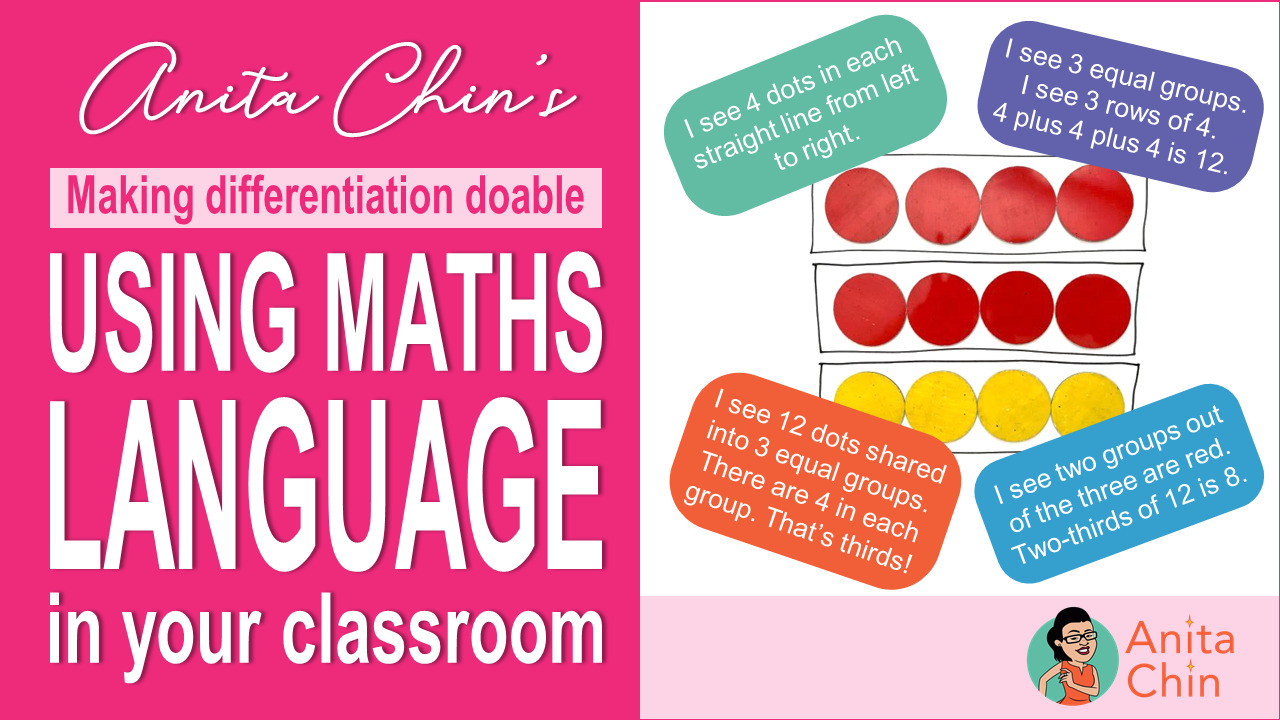
Using maths language in your classroom
I love using mathematical language to differentiate in maths K–6. I use it to signal the start of a maths lesson. It engages the students and makes it clear that they too will be expected to use maths language for the next 60 minutes.
For example, when starting a maths lesson with Year 4 I say ‘Good morning year half of eight’. The class usually looks at me strangely and says ‘We’re not Year 8, we’re Year 4’. I seize this opportunity to get everyone thinking mathematically!
I believe the explicit use of mathematical language is essential for students to connect mathematical concepts and to be able to communicate their reasoning.
For example, building on language that students understand in Kindergarten such as ‘groups of’ through to ‘the product of’ in Year 4 helps students feel empowered with their new ‘fancy word’ for a concept they already understand!

My warm-up task example: ‘What do you see?’
For us as teachers, we can use maths language as a tool to DIFFERENTIATE our instruction to meet the needs of every learner in our classroom. To achieve this, students need plenty of opportunities to HEAR maths language and to SAY/USE maths language to describe what they see and/or communicate their reasoning. Therefore, we must intentionally PLAN to use maths language and MODEL maths language.
Let’s now take a look at how I implement this in the classroom. Click on the dot array to open it in a lightbox and use it in your classroom. If your students need a scaffold, you can also click on each set of speech bubbles to view them in a lightbox.
What might a student with understanding at Kindergarten say?
What might a student with understanding at Year 1 or 2 say?
What might a student with understanding at Year 3 or 4 say?
What might a student with understanding at Year 5 or 6 say?
That’s the power of maths language as a tool for differentiation! You can engage every student, no matter what their level of understanding.
And… you can ASSESS student understanding ‘on the fly’ by listening to the maths language they use.
What would we love our students to say when asked ‘What do you see’?
Of course, that depends on a lot of things: grade level, each student’s ability, what each student has understood (and remembered!) from previous grades and what they have learned so far this year. And how much mathematical language they have engaged with in the past.
Here’s some responses I’d expect in a developmental sequence from Kindergarten to Year 6.
Click on the table to open it in a lightbox for easier reading.
Why do I do this task?
Here’s seven super cool reasons!
It increases STUDENT ENGAGEMENT!
It gives every student the OPPORTUNITY to say something. Their responses may only be ‘red’, ‘yellow’, ‘dots’ or ‘circles’. But the point is, everyone can engage with it and ‘have a go’.
Students get to practise SPEAKING maths language.
Students get to LISTEN to others using maths language.
I can intentionally MODEL mathematical language.
I can ASSESS ‘on the fly’: what does each student know and what do they understand?
But the biggest reason of all: it allows me to DIFFERENTIATE to meet the needs of the full range of learners in my classroom!
Where and when can you use this in your lesson?
I display this image to the class:
- on the teacher magnetic whiteboard using red and yellow magnetic dots; or
- on an interactive panel using the online maths syllabus (2012) and then annotating over it.
I use this teaching idea either:
- as a lesson warm-up to ‘hook’ students, assess prior knowledge and connect concepts; or
- to explicitly introduce new content after the lesson warm-up.
But… you’ll need to meet your students where they are at, right?
And that means you’ll need to DIFFERENTIATE! Sure, you’ll need to know the development of maths language from Kindergarten to Year 6 for the content you’re teaching. But once you do, you’ll be able to engage all your students in whole-class instruction while simultaneously:
- supporting students who need further practise of prior learning
- introducing new maths language that is on-grade
- extending high-potential learners by challenging them to ‘use’ language they know to justify their thinking.
How can I possibly learn all the maths language from Kindergarten to Year 6?
Good question. I’ve made differentiation with maths language doable for you with my teacher language word walls!
A language word wall is a single A4 page that shows the developmental sequence of language for a single substrand/concept from Kindergarten to Year 6. It allows teachers to see at a glance the maths language they should expect their students to know from previous learning as well as where the language goes in future learning.
Want to learn more about my teacher language word walls? View the blog here.
Where do I get Anita’s teacher language word walls?
You can download my teacher language word walls for all 16 substrands from the resources page of my website here.
Keep them handy when planning your lessons or even take them with you to class as your ‘cheat sheet’!
For my ‘What do you see?’ task you’ll need my Multiplication and Division language word wall. If you really want to connect concepts, I recommend downloading the words walls for 2D Space and Position as well.









